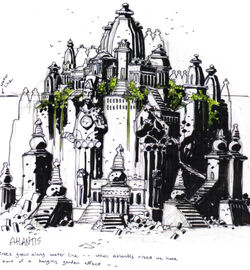The design process is plugging along apace, but we're hitting the point where rubber must needs come into contact with road, and decisions - they gots to be made.
I've had a few people remark - either in response to blog posts or in private messages - their feelings on a few key mechanical decisions. One of those that has generated the most heat is the idea of rolling high or rolling low. Let me do a quick comparison of the pros of the two approaches:
- Rolling Low Pros: It's easy to navigate; ability checks already use this system; it's got an old school vibe.
- Rolling High Pros: It's more intuitive; attack rolls already use this system; it's got a more modern vibe.
Let's do a brief comparison of the mechanical differences using a saving throw as a baseline for comparison:
In roll low, let's say my fighter 6 has a save of 10 (a 50% chance of success). If he rolls 10 or less on the 1d20 roll, he makes the save. The higher his level, the higher his save rating is going to be, and the wider the range of successful rolls. While it is intuitive that a higher
rating is better, it is somewhat counter intuitive that you want to roll low to be successful, since this goes against what I see as an innate, natural understanding of dice. When you roll a die, you want a big number. Big numbers are better than little numbers. I think that this is a shared psychology of dice rolling; as an old-school player, you have learned to accept that roll low is sometimes good, but I don't think someone new coming to the game would ever agree that this makes sense on the surface. You have to learn to accept it, rather than naturally accepting it. It's the way I always felt about descending AC. I learned to accept it, but it always required a leap of faith... then when 3E rolled out ascending AC, I responded "well duh! I never thought of THAT!"
In roll high, my fighter 6 has a save of +9. In roll high, we'd have to have a target number in place to determine success; this system would use 20 as the default target (we are NOT going with the variable situational DCs of 3E, leaving it to the GM to determine difficulties from a wide range of options). Therefore, if the fighter rolls 11 or more (that same 50% chance as above) on the 1d20, he succeeds. This is somewhat more intuitive, since you have a higher rating AND you want to roll a higher number on the die. This requires a little more math on each roll; I have to add the die result to my rating (and possibly modify this by a situational modifier), so this could mean I have three different numbers to consider in the equation. This is simple math, but it's still math: adding 14+9-2=21 is not hard math, but it's harder than looking at a die and deciding 'yeah, that's lower than my rating. I succeed'.
Of course, this is the exact same level of math that someone has to do every time they make an attack roll, only in this case the target in place of 'AC' is a fixed value rather than a dynamic value based on your foe's armor and coordination.
And in the end, I think that's what must sway the decision on this. I like roll high vs. ascending AC - that is a guarantee to go into the rules. Since a dynamic is already in place for one of the key types of rolls in the game, I should - whenever possible - strive to emulate that same dynamic for other rolls in order to make the game easier to learn and internalize.
I've also found in play testing that when you go back and forth (roll an attack vs. roll a save vs. roll damage vs. roll an ability check), I as the GM have to constantly say 'roll 1d20, and you want a high number' or 'roll 1d20, aiming low'... for a new player, it's going to be a lot easier to say 'roll 1d20' with the default assumption that you want a higher number - whether you are rolling an ability check, a saving throw, or an attack.
One other odd mechanical drawback to roll high (at least, I find it odd) is that by setting the target to 20 on a check, I'm actually spotting someone +5% more than they'd get in roll low; an ability score of 18 will fail a check 10% of the time (on a roll of 19 or 20) in roll low, but will only fail a check 5% of the time (on a roll of 1, since 2+18=20) in roll high. I could change the target for roll high to 21 to keep the math exactly the same, but now we begin moving into counter-intuitive area again. 20 seems like a reasonable target; 21 just seems wonky. I'll just have to accept that characters in this game are 5% more likely to be successful at a check than the same character in another game.
If THAT isn't a selling point, I don't know what is. I could almost make t-shirts... "Saga of the Splintered Realm: Where your Ability Score gives you 5% more on checks!"






